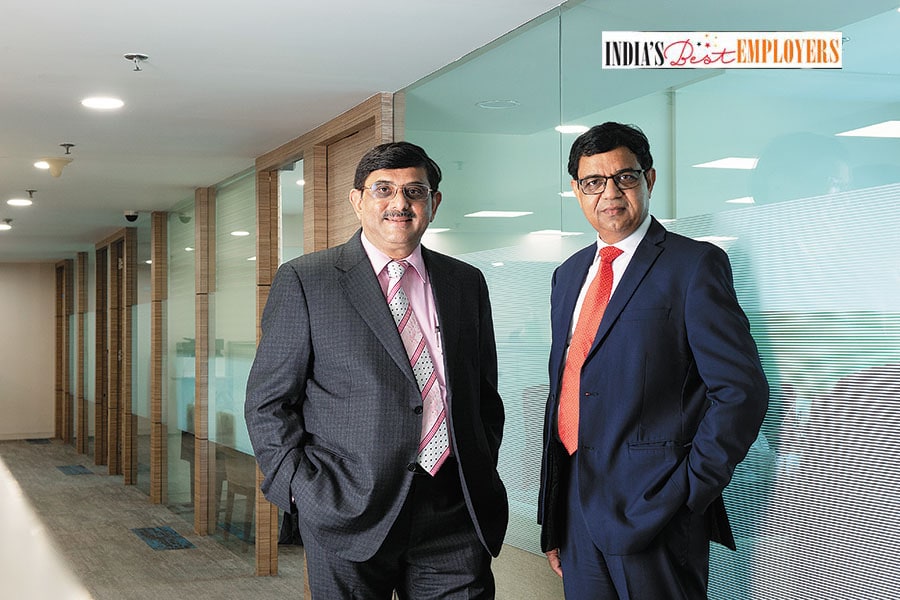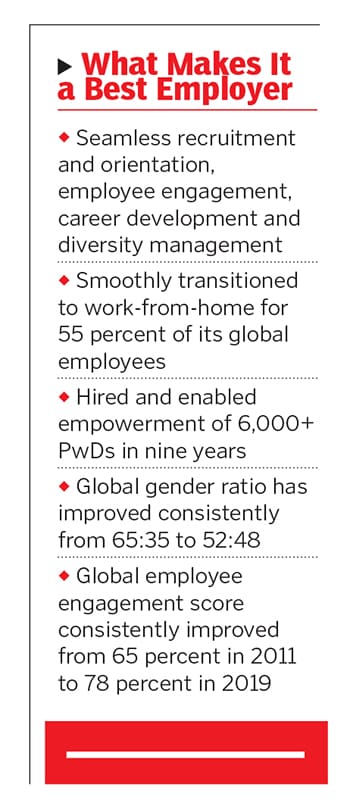
India's Best Employers: Startek, turning crisis into opportunity
Startek was already multicultural and diverse, and it managed to smoothly transition 55 percent of its employees to work from home amid the Covid-19 crisis
 Aparup Sengupta (left), executive chairman and global CEO, Startek, with Dr SM Gupta, global chief people officer
Aparup Sengupta (left), executive chairman and global CEO, Startek, with Dr SM Gupta, global chief people officerImage: Neha Mithbawkar for Forbes India
The Covid-19 pandemic did throw a lot of challenges initially in transitioning to a work at home [WAH] model,” says Dr SM Gupta, global chief people officer, Startek. “Clients were unwilling to allow private and sensitive data to be accessed outside the protected campuses, but the team led from the front and effectively transitioned 55 percent of its global workforce to WAH in 2020.”
US-headquartered Startek, an NYSE-listed company, is a global provider of IT-enabled business process outsourcing solutions to industries such as telecom, technology, media, and more. This is the fourth time in a row that Startek has made it to the list of Best Employers, despite having dealt with a tough year, and the CEO attributes this success to planning a clear WAH strategy, and other systems that were already in place.
In the past year, the organisation institutionalised remote working, relied heavily on virtual interviewing and onboarding, incorporated IT security protocols, and most importantly, “focussed on mental health, and evaluated well-being strategies for employees”, says Aparup Sengupta, executive chairman and global CEO. Additionally, it acted swiftly in putting together mobile clinics, and extended support for everyone working from home. “In a world where customer experience is an integral part of business models, Startek and its approach to digital transformation stood tall during the pandemic, he adds.
“We evaluated our well-being strategy to include safety and prevention measures for Covid-19 and circulated a digital employee handbook to employees, along with multiple banners and numerous videos/webinars for sensitisation,” says Gupta. “We also extended a hand to our differently-abled population for whom this pandemic created even more challenges.”
Manoj Kandoth, CEO at Urrja Corporate Consulting, a management consulting firm, says Startek used the lockdown-induced work-from-home situation to their favour, turning the crisis into an opportunity. “They hired approximately 2,000 people from Tier II and III cities to ride the digitisation and online wave,” he says. “The best part about their training is that they encourage making mistakes, so there is no gap in customer ser

vice. For those whose first job is at Startek, they will have learnt and been exposed to the best in one go.”
A majority of its over-40,000 employees are millennials, working from 46 campuses in 13 countries, says Gupta. “This age group has a strong affinity towards technology, transparent communication, customised learning, growth and well-being, and we at Startek believe we excel in these areas that have helped us retain talent and make the company an attractive place to work.”
The company also got brownie points for its commitment to help employees maintain work-life balance, and their well-being. Along with providing flexible work schedules and paid time off, Startek also offers health coaching in nutrition, has a mental health policy, and conducts health webinars. “This has improved employee morale, increased commitment, improved productivity, decreased absenteeism and reduced turnover,” says Gupta.
Startek has always believed in being inclusive and embracing diversity. Its staff, from 83 nationalities, speaking 37 languages, has helped keep the ethos of its offices multicultural. It goes a step further with its ‘Hexagonal Model of Diversity’ that mandates inclusion of persons with disabilities (PwDs), different genders, socially and economically disadvantaged people, and indigenous people. The company has enabled employment and livelihoods for more than 5,000 PwDs, and improved the gender ratio to 51:49 (male:female) while generating jobs for Tier III and IV cities.
But what really helps employees is the promotion of a culture that encourages mutual support, says Kandoth. It not only trains employees with the skills they need for the job, but also helps with communication, negotiation, creative ways of resolving conflicts, appreciating others, team building and coaching skills. This, he says, is the reason why Startek employees are able to deal with any and all of the clients.
More than 60 percent of their new hire requirement has been met through the company’s internal job postings initiative. Through its Global Talent Exchange Programme, Startek has facilitated cross-border movement of talent. “This ensures that opportunities are also created for people across global campuses,” says Sengupta.
But it’s not just all work and no play. Startek’s Employee Involvement Programmes are aimed at fostering team spirit, breaking the monotony of work, and rejuvenating employees. These could range from games, and sports, family days, dinner with the leadership, food fiesta and a DJ night, but the last year has been different. The company organised webinars on wellness, team motivation, and advisory on Covid-19. It also engaged employees on social media to wish them on their birthdays, spread success stories, conduct games and sent e-newsletters.
All these initiatives aside, Gupta says, their goal has been to engage every single mind in the organisation with meaningful work and provide clarity around the purpose of the company. “We work towards making each one part of the action and allowing everyone to have a voice.”
(This story appears in the 30 November, -0001 issue of Forbes India. To visit our Archives, click here.)








